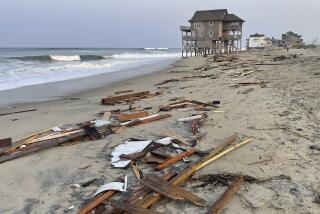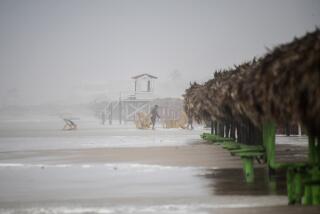Hurricane Season Is Forecast to Be Busy but Not a Blockbuster
MIAMI — Hurricane activity in the Atlantic Ocean will be above long-term averages this year but below the blockbuster hurricane seasons of late, a noted forecaster said Friday.
Colorado State University’s Dr. William Gray predicted a moderate hurricane season of 11 named storms, seven of which will reach hurricane strength with sustained winds of 74 mph or greater.
But three of the storms will be intense hurricanes of Category 3, with winds of 111 mph or more, and the heavily populated East Coast has an above-average chance of being hit by a major storm, Gray said.
“We do not anticipate a season as active as those in 1995, 1996, 1998 or 1999,” Gray said in a statement. “Still, we believe we are entering a new era for increased storm activity and for East Coast landfalls by major storms.”
The Atlantic hurricane season is June 1 to Nov. 30.
The last five years have been the busiest on record collectively for Atlantic hurricanes, and the 1999 season saw some of the most powerful storms ever. For the first time, five Category 4 storms, with winds of 131-155 mph capable of leveling mobile homes and damaging houses, were recorded in the same season.
The 1995 season was the second-busiest on record, with 19 named storms. The average hurricane season has 9.3 named storms, 5.8 hurricanes and 2.2 intense hurricanes.
Circular tropical weather systems are named--and become “tropical storms”--when maximum sustained winds reach 39 mph. They become hurricanes when top winds hit 74 mph.
The Colorado State forecasting team bases its predictions on detailed analysis of world weather phenomena, including high-level winds, rainfall in Africa and the El Nino/La Nina Pacific Ocean water temperature factor.
Gray said it is unlikely an El Nino--the Pacific warm-water phenomenon that dampens hurricane activity--will form this year.
The forecast called for the U.S. Atlantic coast to have a 39% chance of seeing one or more major hurricanes, above the 100-year mean of 31%. The Gulf of Mexico coast faces a 34% probability, above the long-term 30%.
The prospect of the Caribbean being hit by a major storm is 10% above average.
More to Read
Sign up for Essential California
The most important California stories and recommendations in your inbox every morning.
You may occasionally receive promotional content from the Los Angeles Times.









